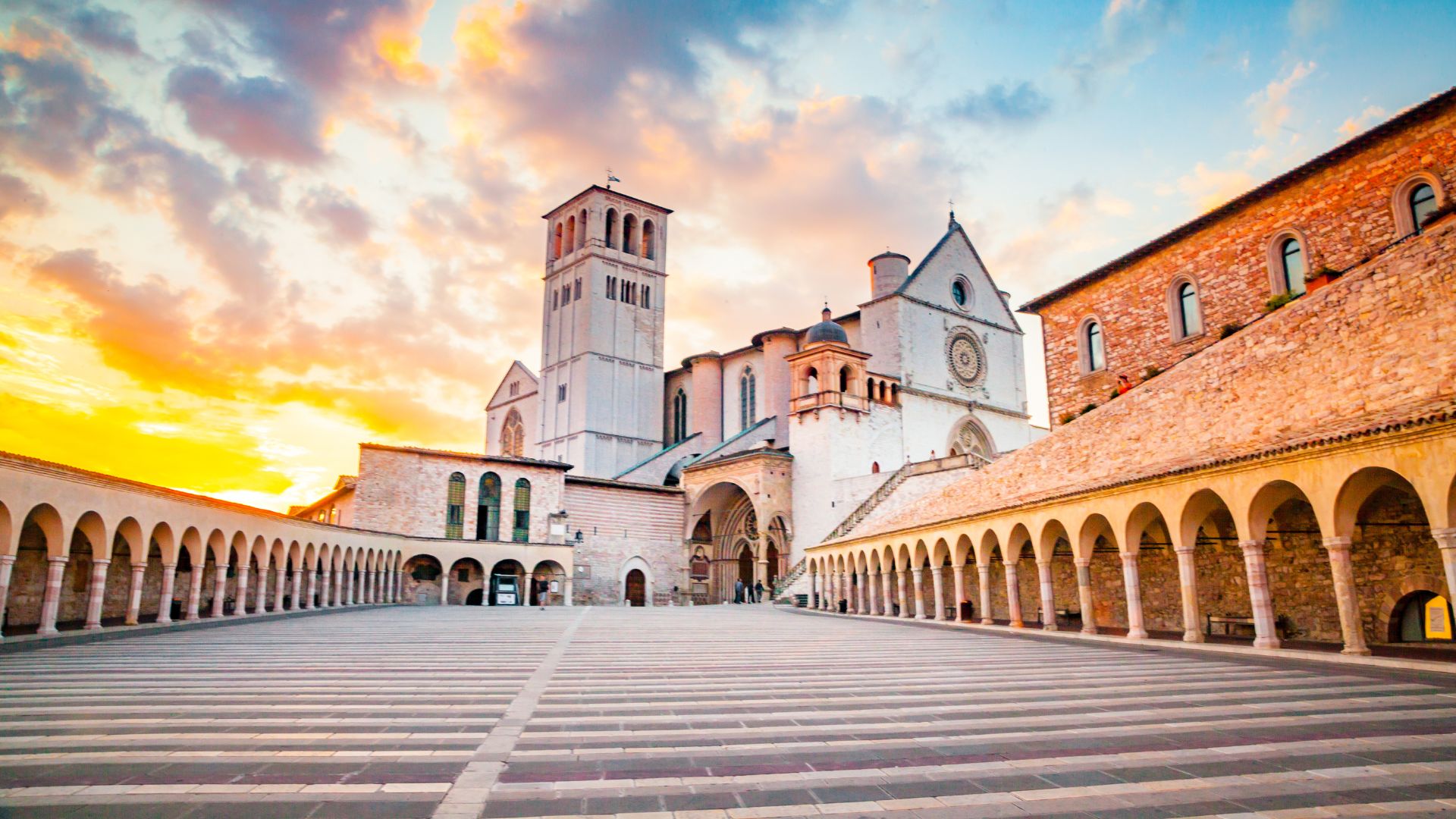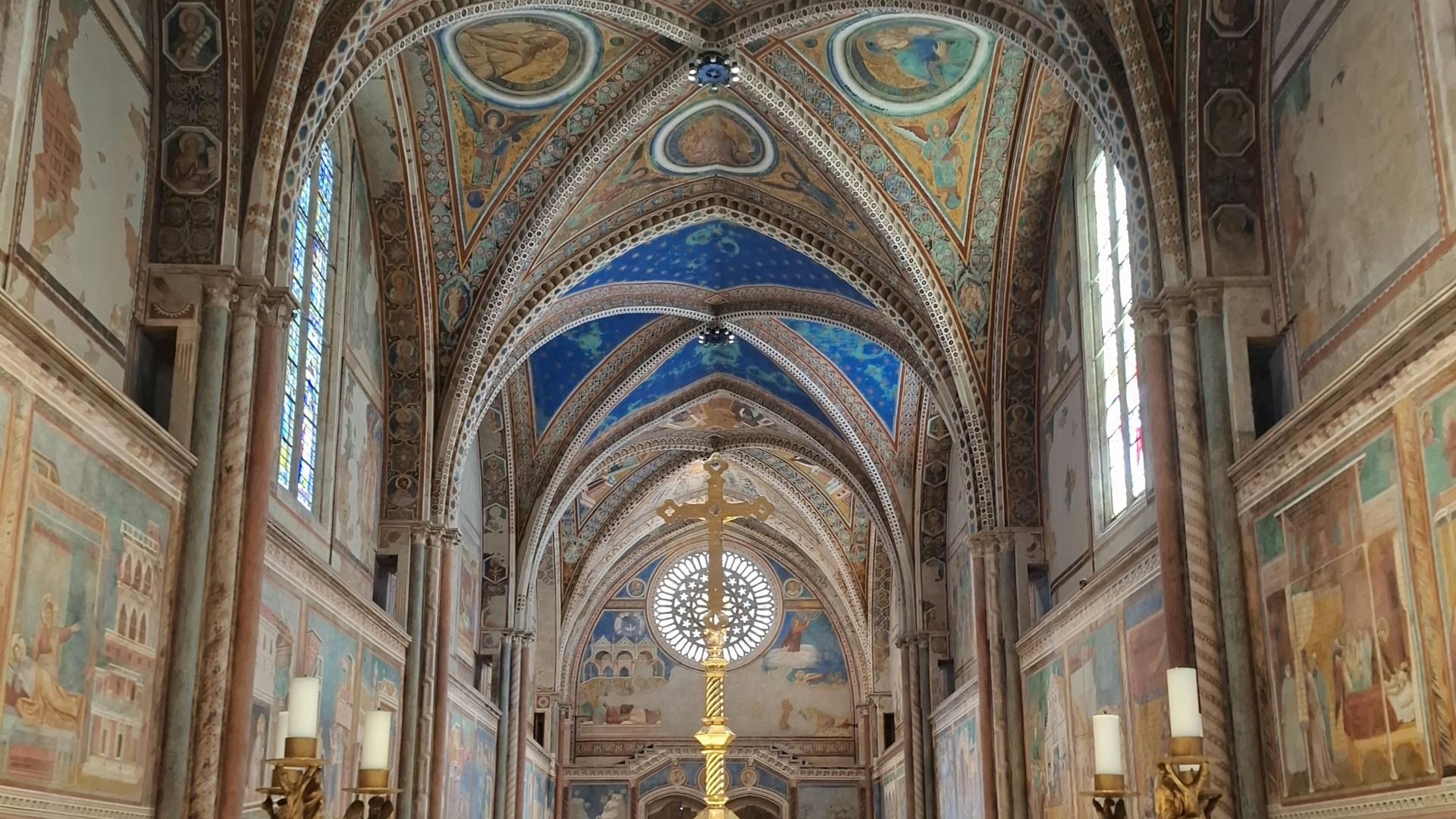The moment I stepped into the Basilica of St. Francis in Assisi, time seemed to stand still. Sunlight streamed through ancient stained glass, illuminating frescoes that have inspired pilgrims for centuries.
Walking these sacred halls stirred something deep within me – a connection to history, faith, and the remarkable legacy of a man who chose simplicity over wealth.
My journey to Assisi wasn’t just another travel destination to check off my list. This small Italian hilltown holds a spiritual aura that’s impossible to describe until you’ve felt it yourself.
The basilica, with its two-level structure and incredible artwork, stands as both a monument to Francis’s humble teachings and, ironically, the grand devotion his followers felt toward him.
What struck me most was how the spirit of St. Francis remains alive throughout Assisi. Between the quiet contemplation at San Damiano, where Francis heard his calling, to the bustling Piazza del Comune, where locals still gather, Assisi offers more than just beautiful views of the Umbrian countryside.
It provides a chance to reflect on Francis’s timeless message of simplicity, peace, and love for all creation – something I found myself carrying home long after my visit ended.

The Spiritual Magnitude of Assisi
Assisi radiates a spiritual energy that’s almost tangible when you walk its ancient streets. The town carries the peaceful yet powerful essence of St. Francis’s legacy, creating an atmosphere where even skeptics might feel something beyond the ordinary.
Exploring the Birthplace of St. Francis
Born to a wealthy merchant family in 1182, St. Francis transformed this hillside town into a spiritual beacon. Walking through Assisi’s narrow medieval streets, I felt connected to his journey of renunciation and simplicity.
The town itself seems designed for spiritual reflection. Stone buildings bathed in golden Umbrian light create perfect spaces for quiet contemplation.
What struck me most was how the entire city feels like a living monument to Francis’s ideals. Locals still honor his teachings about care for creation and simplicity.
Many visitors I met described feeling a “breath of the Spirit” here, echoing the search results’ description of Francis’s impact. This isn’t just religious tourism – it’s a place where his radical commitment to poverty and compassion remains palpable.

Significance of the Franciscan Movement
The Franciscan movement revolutionized Christian spirituality by emphasizing direct connection with God through nature and service to the poor. This radical approach remains relevant today.
St. Francis’s teachings on environmental stewardship make him surprisingly modern. His famous Canticle of the Creatures, which praises “Brother Sun” and “Sister Moon,” established him as a patron of ecology centuries before the environmental movement.
The Franciscan order he founded continues his mission worldwide. I witnessed monks in their brown robes still practicing his ideals of simplicity and service.
Francis challenged the materialism and power structures of his time, much as they challenge ours today. His embrace of “Lady Poverty” was a radical critique of wealth inequality that still resonates.

For both Catholic and non-Catholic visitors, Assisi offers a powerful reminder of how one person’s spiritual journey can create lasting change in the world.
Journey Through the Basilica
The Basilica of St. Francis is a spiritual and artistic masterpiece that took my breath away. As I wandered through its hallowed halls, I discovered a perfect blend of architectural genius and artistic splendor that tells the story of one of Christianity’s most beloved saints.
Architectural Wonders of the Basilica
The basilica is two churches built one atop the other. I started in the Lower Church, with its low ceilings and somber atmosphere that instantly created a sense of reverence.
The space feels intimate and contemplative, with ribbed vaults and sturdy columns supporting the structure.
Moving to the Upper Church was like stepping into a different world. Sunlight streams through Gothic windows, illuminating the soaring ceilings and airy space. The contrast between the two churches is intentional, representing St. Francis’s journey from earthly humility to heavenly glory.
Built in the 13th century, the basilica combines Romanesque and Gothic elements in a way that feels both grounded and uplifting. I was particularly struck by the bell tower, standing tall against the Umbrian hillside.

Artistic Heritage: Giotto’s Frescoes
The walls of the basilica come alive with stunning frescoes that tell St. Francis’s story. In the Upper Church, Giotto’s 28 scenes chronicle the saint’s life with remarkable emotion and realism. I stood mesmerized before “The Sermon to the Birds,” where Francis’s gentle connection with nature is beautifully captured.
These frescoes represent a pivotal moment in Western art. Giotto broke from rigid Byzantine traditions, introducing natural poses, emotional expressions, and realistic settings. I could see why art historians consider this work the beginning of Renaissance painting.
The colors remain vibrant despite the centuries, with blues and golds that seem to glow in the soft light. Each fresco tells a story, from Francis’s rejection of worldly goods to his receiving the stigmata. Standing before these masterpieces, I felt connected to both the saint’s journey and the artistic revolution his story inspired.

Personal Reflections and Revelations
My visit to the Basilica of St. Francis transformed me in ways I never expected. The sacred spaces opened my heart to profound insights that continue to shape my spiritual journey today.
Moments of Awe and Humility
Standing before the tomb of St. Francis, I felt an overwhelming sense of smallness mixed with wonder. The simplicity of his life contrasted sharply with the grandeur built to honor him. I found myself breathing differently, more slowly, as if the very air carried centuries of prayers.
A family praying nearby caught my attention – three generations kneeling together in silent reverence. Their obvious connection reminded me that faith transcends time.
The frescoes depicting Francis’s life story made me pause and consider my own choices. How often do I choose comfort over purpose? The question lingered as I traced my fingers along the cool stone walls.
My heart felt strangely full yet unburdened at the same time. This paradox seems to embody Francis’s spirit – both profound and accessible.

Encountering Peace Through Prayer
Finding a quiet corner in the Lower Basilica, I closed my eyes and simply listened. The gentle echoes of distant footsteps mixed with whispered prayers created an unexpected soundtrack to contemplation.
Many visitors rushed through, checking items off their travel lists. I chose to stay longer, allowing the peace to sink deep into my bones. This unhurried approach yielded the richest rewards of my entire journey.
I noticed my thoughts becoming clearer, less cluttered with everyday worries. The basilica seemed to offer a natural invitation to gratitude – for beauty, for history, for the chance to stand in this sacred space.
Writing in my journal later, I realized the most powerful souvenir wasn’t something I could photograph or purchase. It was this renewed sense of inner calm that traveled home with me.

Connecting with Nature and History
Assisi offers a unique blend of natural beauty and historical significance that deeply enriches any visitor’s experience. The town’s setting among the Umbrian hills creates a perfect backdrop for understanding St. Francis’s spiritual journey.
St. Francis’s Love for Creation
Walking through Assisi, I felt a special connection to St. Francis’s celebrated love for nature. The saint famously preached to birds and called all creatures his brothers and sisters. This profound respect for the natural world remains palpable throughout the town.
From the basilica’s hilltop position, I gazed across the stunning Umbrian valley. The landscape hasn’t changed much since Francis walked these hills in the 13th century.
Olive groves and cypress trees dot the countryside, creating a serene atmosphere that explains why Francis found such spiritual inspiration here. Many pilgrims follow the nature trails around Assisi to experience this connection firsthand.
The basilica’s frescoes also depict Francis’s bond with animals and nature, showing him speaking to birds and taming the wolf of Gubbio. These stories remind visitors of his revolutionary view that all creation deserves respect.

The Presence of the Past: From Dante to Today
Assisi’s stones seem to whisper stories spanning centuries. The basilica itself represents a historical turning point in art and architecture, showcasing early Renaissance innovations.
Dante mentioned Assisi in his Divine Comedy, praising Francis and emphasizing the town’s importance. I found it moving to walk where so many historical figures have traveled before me.
Roman ruins peek through medieval structures throughout town, creating layers of history visible at every turn. The Temple of Minerva, now a church, stands as testimony to Assisi’s ancient roots.
The basilica’s frescoes by Giotto and Cimabue revolutionized Western art, introducing naturalism and emotional depth. These masterpieces attract art historians and casual visitors alike.
I noticed how past and present blend seamlessly here. Local artisans still create crafts using traditional methods, while cafés bustle with modern travelers seeking their spiritual connection.
Navigating Assisi as a Pilgrim
Planning a pilgrimage to Assisi requires thoughtful preparation to fully experience the spiritual richness of St. Francis’s hometown. The winding medieval streets and sacred sites offer countless opportunities for both personal reflection and meaningful connections with fellow travelers.
Crafting Your Itinerary: From Orvieto to Venice
I found that approaching Assisi as part of a larger Italian journey enhanced my pilgrimage experience. Starting in Orvieto gave me time to adjust to Italy’s rhythm before arriving in Assisi. The train connections are straightforward, though I recommend booking tickets in advance during peak season.
Allow at least two full days in Assisi itself. The town is walkable but hilly, so comfortable shoes are essential! Many pilgrims stay in simple guest houses run by religious orders, offering an authentic experience.
For my itinerary, I planned:
- Morning: Basilica of St. Francis
- Afternoon: San Damiano
- Evening: Sunset at Rocca Maggiore
Continuing to Venice afterward provided a beautiful contrast to Assisi’s quiet spirituality. The journey takes about 5-6 hours by train with a connection in Florence.
Finding Opportunities for Reflection and Community
The true pilgrimage experience in Assisi comes through balancing personal reflection with community engagement.
I discovered several hidden spots perfect for quiet contemplation. One of these spots is the woodland path where St. Francis reportedly spoke with birds.
Many religious houses offer evening prayers open to visitors. Joining these services connected me with pilgrims from around the world, creating unexpected friendships.
Local hospitality extends beyond religious settings. Family-run restaurants often become gathering places where pilgrims share stories over simple Umbrian meals.
The “pilgrim’s dinner” at Trattoria degli Umbri became a highlight of my journey.
Don’t miss the early morning walk to Eremo delle Carceri. The hermitage nestled among oak trees provides a powerful space for reflection before the day’s tourists arrive.


